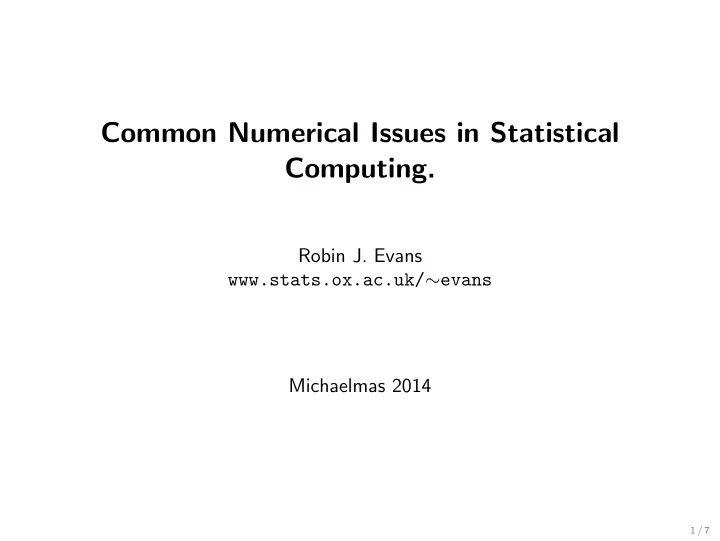

Common Numerical Issues in Statistical Computing. Robin J. Evans www.stats.ox.ac.uk/ ∼ evans Michaelmas 2014 1 / 7
Algorithmic Considerations Some methods of computing things are easier than others. Multiplying n × m matrix by m × k matrix is O ( nmk ) calculations. 2 / 7
Algorithmic Considerations Some methods of computing things are easier than others. Multiplying n × m matrix by m × k matrix is O ( nmk ) calculations. Let A be n × m , B be m × k , and c be k × 1. ABc = ( AB ) c = A ( Bc ) But ( AB ) c takes O ( nmk + nk ), and A ( Bc ) takes O ( mk + nm ). 2 / 7
Algorithmic Considerations Some methods of computing things are easier than others. Multiplying n × m matrix by m × k matrix is O ( nmk ) calculations. Let A be n × m , B be m × k , and c be k × 1. ABc = ( AB ) c = A ( Bc ) But ( AB ) c takes O ( nmk + nk ), and A ( Bc ) takes O ( mk + nm ). A = matrix(rnorm(1e4), 100, 100); B = matrix(rnorm(1e4), 100, 100) c = rnorm(100) library(microbenchmark) microbenchmark(A %*% B %*% c, A %*% (B %*% c), times=100) ## Unit: microseconds ## expr min lq median uq max neval ## A %*% B %*% c 700.8 711.96 715.41 719.91 1426.40 100 ## A %*% (B %*% c) 64.8 65.11 65.22 65.52 85.81 100 R evaluates left to right in this case. 2 / 7
Numerical Stability Considerations Floating point numbers have a limited accuracy (usually around 10 − 16 for an O (1) number). 0.3 - 0.2 - 0.1 ## [1] -2.776e-17 3 / 7
Numerical Stability Considerations Floating point numbers have a limited accuracy (usually around 10 − 16 for an O (1) number). 0.3 - 0.2 - 0.1 ## [1] -2.776e-17 summary(A %*% B %*% c - A %*% (B %*% c)) ## V1 ## Min. :-1.99e-13 ## 1st Qu.:-2.84e-14 ## Median : 1.42e-14 ## Mean : 8.52e-15 ## 3rd Qu.: 4.35e-14 ## Max. : 2.42e-13 3 / 7
Numerical Stability Considerations Floating point numbers have a limited accuracy (usually around 10 − 16 for an O (1) number). 0.3 - 0.2 - 0.1 ## [1] -2.776e-17 summary(A %*% B %*% c - A %*% (B %*% c)) ## V1 ## Min. :-1.99e-13 ## 1st Qu.:-2.84e-14 ## Median : 1.42e-14 ## Mean : 8.52e-15 ## 3rd Qu.: 4.35e-14 ## Max. : 2.42e-13 Problems of numerical accuracy can be solved with long doubles in languages like C. 3 / 7
Arithmetic Precision R may hide some of these rounding issues, so don’t forget that they exist! 1+1e-15 ## [1] 1 print(1+1e-15, digits=22) ## [1] 1.000000000000001110223 4 / 7
Arithmetic Precision R may hide some of these rounding issues, so don’t forget that they exist! 1+1e-15 ## [1] 1 print(1+1e-15, digits=22) ## [1] 1.000000000000001110223 R also has an integer type (but it’s a bit tricky) 1 == 1L ## [1] TRUE identical(1, 1L) ## [1] FALSE 4 / 7
Arithmetic Precision Equality testing may be problematic with floating point numbers: x = 1+1e-15 x == 1 ## [1] FALSE all.equal(x, 1) ## [1] TRUE 5 / 7
Arithmetic Precision Equality testing may be problematic with floating point numbers: x = 1+1e-15 x == 1 ## [1] FALSE all.equal(x, 1) ## [1] TRUE all.equal() ignores small differences in numbers, and also their type. all.equal(1L, 1) ## [1] TRUE 5 / 7
Numerical Stability Considerations Floats also have an upper and lower limits on the numbers they can hold c(2^-1074, 2^-1075) ## [1] 4.941e-324 0.000e+00 c(2^1023, 2^1024) ## [1] 8.988e+307 Inf 6 / 7
Numerical Stability Considerations Floats also have an upper and lower limits on the numbers they can hold c(2^-1074, 2^-1075) ## [1] 4.941e-324 0.000e+00 c(2^1023, 2^1024) ## [1] 8.988e+307 Inf You may need to think carefully about the way in which you compute things c(2^(2000-1993), 2^2000/2^1993) ## [1] 128 NaN 6 / 7
Numerical Stability Considerations Additive computations are generally much more stable than multiplicative ones. 7 / 7
Numerical Stability Considerations Additive computations are generally much more stable than multiplicative ones. Suppose you want to calculate the geometric mean of some numbers set.seed(324) geomean = function(x) prod(x)^(1/length(x)) x = rlnorm(1e3, meanlog=-1) # log-normals geomean(x) ## [1] 0 range(x) ## [1] 0.01134 9.73558 7 / 7
Numerical Stability Considerations Additive computations are generally much more stable than multiplicative ones. Suppose you want to calculate the geometric mean of some numbers set.seed(324) geomean = function(x) prod(x)^(1/length(x)) x = rlnorm(1e3, meanlog=-1) # log-normals geomean(x) ## [1] 0 range(x) ## [1] 0.01134 9.73558 If we do everything on a log-scale, there’s no problem geomean2 = function(x) exp(mean(log(x))) geomean2(x) # approximately exp(-1) ## [1] 0.3597 7 / 7
Recommend
More recommend